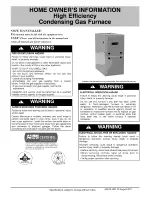
67
Adjust Cooling Airflow
The cooling airflow can be set from the remaining blower speed
taps. Refer to the Air Delivery Tables in these instructions.
FURNACE OVERHEATING HAZARD
Failure to follow this caution may result in reduced furnace
life.
Recheck temperature rise. It must be within limits specified
on the rating plate. Recommended operation is at the
mid--point of rise range or slightly above.
CAUTION
!
Adjust Thermostat Heat Anticipator
Mechanical thermostat
: Set thermostat heat anticipator to match
the amp draw of the electrical components in the R--W circuit.
Accurate amp draw readings can be obtained at the wires normally
connected to thermostat subbase terminals R and W.
The
thermostat anticipator should NOT be in the circuit while
measuring current.
1. Remove thermostat from subbase or from wall.
2. Connect an amp meter across the R and W subbase termin-
als or R and W wires at wall.
3. Record amp draw across terminals when furnace is in low
heat and after blower starts.
4. Set heat anticipator on thermostat per thermostat instruc-
tions and install on subbase or wall.
5. Install blower access door.
Electronic thermostat
: Set cycle rate for 3 cycles per hr.
Check Safety Controls
The flame sensor, gas valve, and pressure switch were all checked
in the Start--up procedure section as part of normal operation.
1. Check Main Limit Switch
This control shuts off combustion system and energizes air--
circulating blower motor, if furnace overheats. By using this
method to check the temperature limit control, it can be es-
tablished that the limit is functioning properly and that the
limit will operate if there is a restricted return--air supply or
motor failure. If the limit control does not function during
this test, the cause must be determined and corrected.
a. Run furnace for at least 5 minutes.
b. Gradually block off return air with a piece of cardboard or
sheet metal until the limit trips.
c. Unblock return air to permit normal circulation.
d. Burners will re--light when furnace cools down.
2. Check Pressure Switch(es)
This control proves operation of the draft inducer blower.
a. Turn off 115--v power to furnace.
b. Disconnect inducer motor lead wires from wire harness.
c. Turn on 115--v power to furnace.
d. Set thermostat to “call for heat” and wait 1 minute. When
pressure switch is functioning properly, hot surface igniter
should
NOT
glow and control diagnostic light flashes a
status code 31. If hot surface igniter glows when inducer
motor is disconnected, shut down furnace immediately.
e. Determine reason low pressure switch did not function
properly and correct condition.
f. Turn off 115--v power to furnace.
g. Reconnect inducer motor wires, replace outer door, and
turn on 115--v power.
h. Blower will run for 90 sec before beginning the call for
heat again.
i. Furnace should ignite normally.
Checklist
1. Put away tools and instruments. Clean up debris.
2. Verify that the jumper is removed from the TEST/TWIN
terminal. Verify that there is nothing plugged into the PLT
connector. (Note: If there is a jumper connector plugged
into PLT, remove it and discard.) See Fig. 38.
3. Verify that the Blower/Heat Off Delay jumpers are set as
desired. See Fig. 38 and 70.
4. Verify that the blower (lower door in upflow position) and
control (“Main” or upper door in upflow position) doors are
properly installed.
5. Verify that the Status LED glows. If not, check that the
power supply is energized and that the blower door is
secure. See Fig. 61 to interpret diagnostic codes.
6. Cycle test furnace with room thermostat to be sure that it
operates properly with the room thermostat. Check all
modes including Heat, Cool and Fan.
7. Check operation of accessories per manufacturer’s
instructions.
8. Review Owner’s Manual with owner.
9. Attach entire literature packet to furnace.
59SC
2C
















































